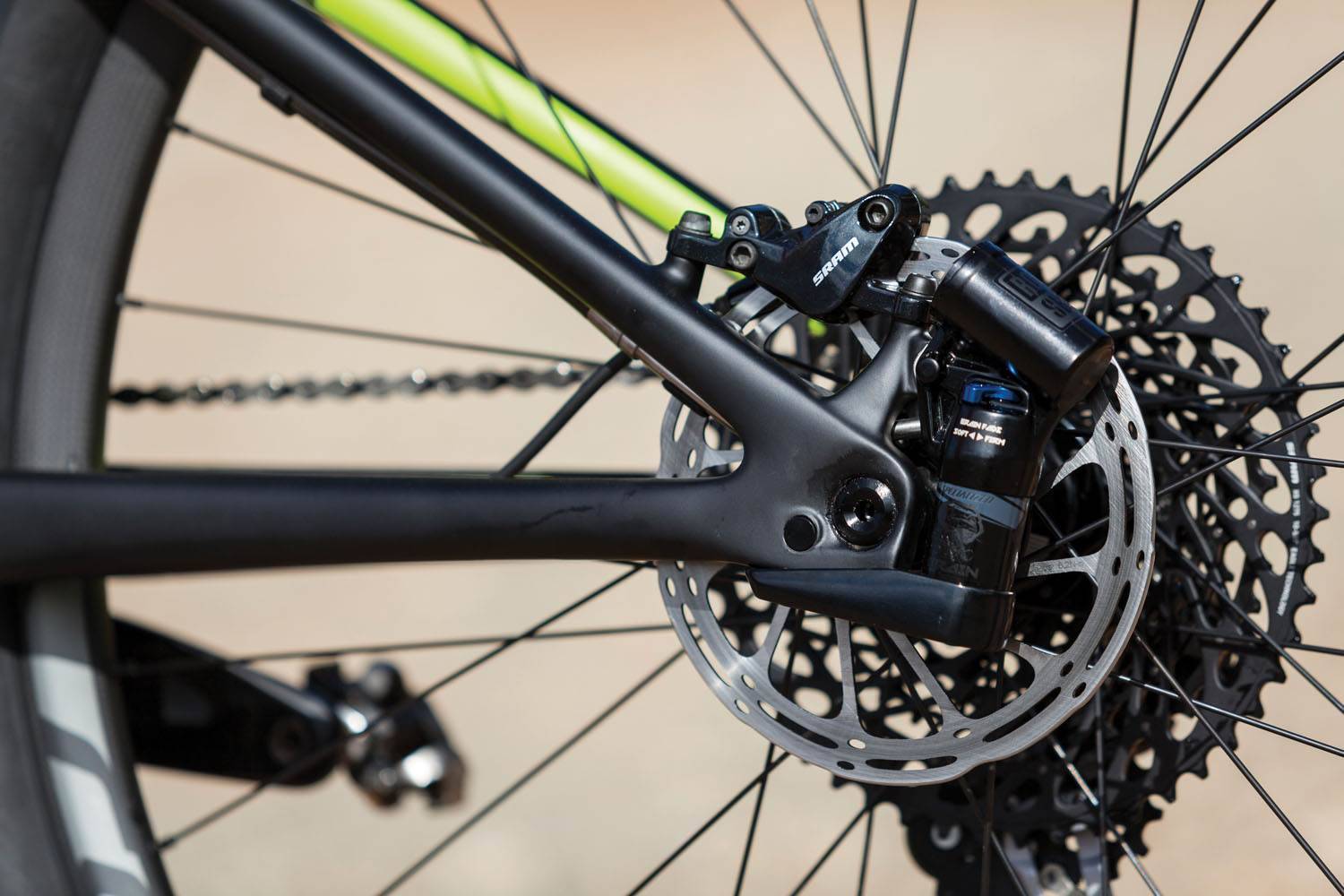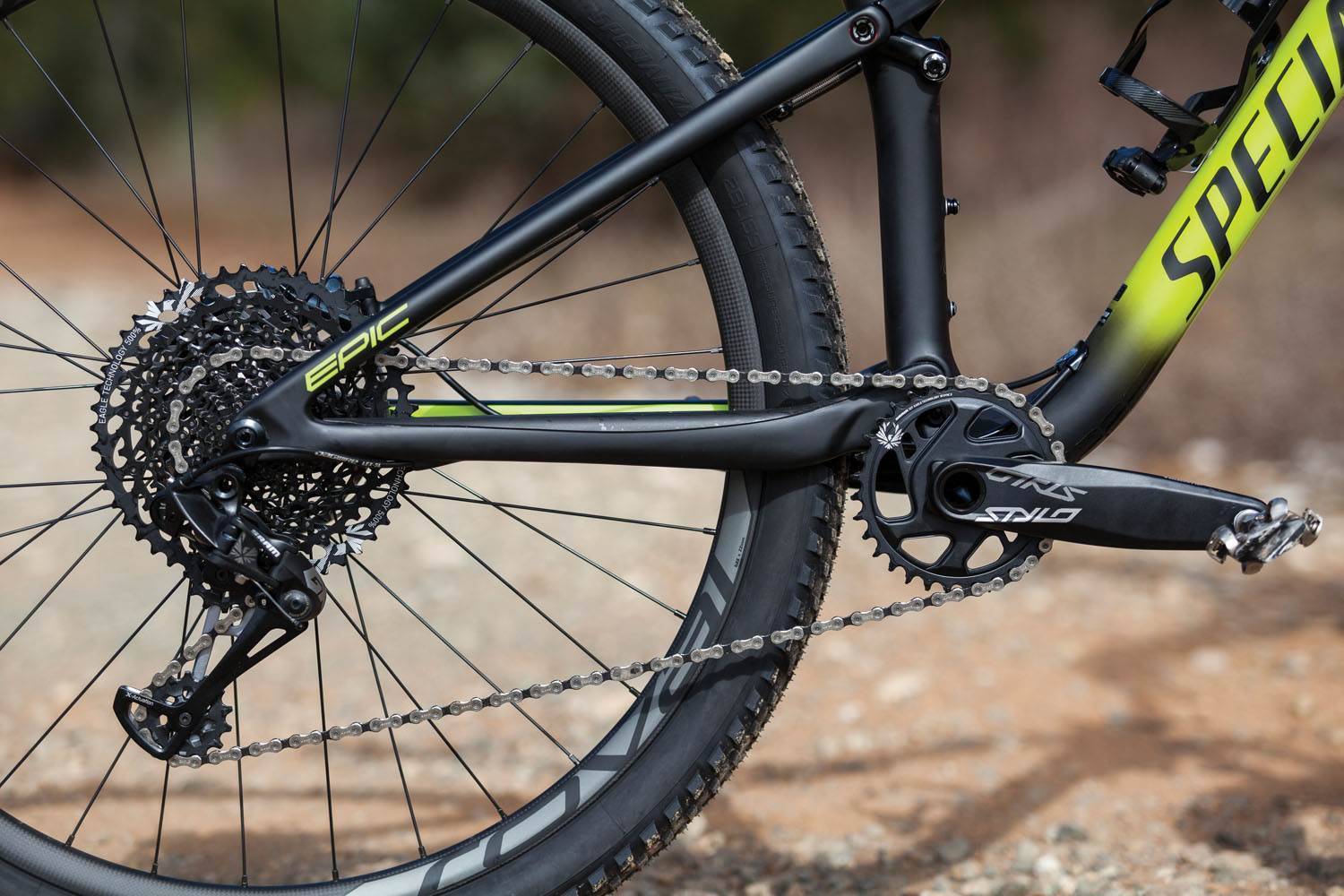TESTED: Specialized Epic Expert
The Epic Expert proves to be a great XC race bike offering bucket loads of fun.
Photographer: Nick Waygood Words: Ben Morrison
2018 sees a major overhaul of one XC’s winningest bikes! Gone is the FSR pivot, once the backbone of Specialized’s suspension platform, which is now replaced by flex stays (helping save 525g on the Expert level, just off the frame). We also see a brand new smoother, faster and more interesting looking Brain shock from RockShox.
All of this and more makes the Epic one of the fastest bikes around and you can see right away why this machine has taken so many trips to the top of the podium. We are seeing fewer Specialized athletes running their hardtail and instead reaching for their Epic. It’s easy to understand why when presented with a 100mm travel XC race bike that climbs so well and descends like a champion. The point is that offerings like the Epic are starting to blur the lines about what XC riding is – and what you can do on an XC bike.
Using the Rider-First Engineered concept, which gives each frame size unique carbon layups and tube profiles, along with real world testing on World Cup XC tracks that would push some trail bikes to their limits, the 2018 Epic gives a much more aggressive ride. With longer top tubes, shorter rear ends, less frame flex from the rear wheel and shorter stems, it snaps out of every turn with all the speed you came into it with. Oh and did we say it was fast? Even with the Brain set to full soft the Epic picks up every little bit of effort you put through the pedals, helping you up climbs or into the first bit of singletrack before everyone else. No wonder it grabbed a few medals at the recent XCO World Championships.

A closer look at the new Epic
Harder, Better, Faster, Stronger! Wait, strike that, we’re not here to chant remixes of French duo Daft Punk and Kanye West, we’re here to explore Specialized’s all-new Epic Expert – LIGHTER, SMARTER, FASTER!
Our first impression when looking at the bike is that it looks fast; think Formula One race car. It isn’t weighed down with things you don’t need. Rather, it contains what could be considered gold – Specialized’s Brain 2.0 – but more on that later. Our Epic Expert came in satin hyper green/black – but an outstandingly cool and understated satin charcoal/black/rocket red is also available in Australia.
Before getting into the performance of our Epic Expert, let’s delve into this lyrical Lighter, Smarter, Faster…
Lighter: Specialized have reduced the weight of the Epic range using their Rider-First Engineered technology that was originally introduced with the Tarmac SL5 road bike a few years ago. It provides for engineering layups and various tube shapes to fit perfectly with every frame, regardless of size, enhancing the rider experience. Specialized are able to hold an outstanding stiffness-to-weight ratio without compromising on comfort or handling, all while moving to a more aggressive trail-friendly geometry.
Further, in delivering their mission to reduce weight and be lighter, Specialized have removed pivots from the rear end, not only aiding in their weight-loss quest, but also moving the Epic into the single-pivot bike category. They have successfully designed and engineered flex zones (flex stays) in both the chain and seatstays that will match the performance of the well-known and loved FSR systems. Now that the bike is lighter, Specialized needed to go back and rethink the suspension.
Smarter: Specialized’s Brain technology has been redesigned in conjunction with industry heavy-hitters RockShox to give us Brain 2.0 – taking everything that was great from the earlier versions and building upon it. Specialized say that moving the Brain reservoir closer to the axle (the first point where the suspension starts to be affected by bump inertia) makes for a more responsive system than ever before. Not techno-geek enough? Here it is direct from the horse’s mouth:
“Oil porting and flow paths have been re-engineered to reduce oil turbulence and provide more consistent damping. The suspension team also addressed hose fitting, so there are no frame rub issues, making this the most visually sleek Brain package yet. Now, hoses that route oil, flow directly through the shock extension, taking out unnecessary curves and fittings.” And that brings us to the best and final part of the design brief.
Faster: This is perhaps one of the best reasons to consider trading in your old Epic for a new one. XC racing and general riding has significantly changed over the years; riders are now using dropper posts, not just for descending, but sometimes to aid in the ability to adjust body positons for navigating high speed technical sections. Gone are the race courses that resembled walking paths through your local park (these are now CX tracks). With World Cup XC courses having increasingly technical sections of trail that look like they are right out of a round of the Enduro World Series, Specialized knew they had to address some of the less stable and often confidence-sapping geometry of XC bikes in order to help racers and riders alike push the boundaries of the sport.
Specialized increased the reach to make for a longer and more stable front end. They have also shortened the stem length across all sizes by 10mm, which makes for quick handling. The head angle was slackened by 1.5 degrees to create an aggressive 69.5 degree angle. Those simple changes combine to create a bike that’s more confident at speed and descending through steep and rough terrains – all of which is perfectly matched with the new design and the added gold of Brain 2.0.
The Epic Expert model we tested had a full carbon rear end, and with the move away from the FSR pivot to the flex stays there are savings of around 525g. We tested a medium, which is outstanding considering medium-sized S-Works only achieves around 345g of weight-loss. Specialized say this is a first for them! To match this newly aggressive geometry, Specialized also made sure that the Epic range is now compatible with dropper posts; not only the short-travel Command Post XCP Specialized make, but full length droppers.

Get it dialled
The Epic will reward your time spent on suspension setup. The new Brian 2.0 rear shock still comes with Specialized’s auto sag button, which will aid in getting the ball rolling with your setup. Once you have the sag sorted, it’s time to hit the trails. Be sure to take a shock pump with you as it’s possible that your excited bounce around the driveway during setup may have given a false sense of the correct sag. New forks and shocks have a break-in period which might mean that if your first ride is a short one, everything might get softer as the seals loosen up and your new suspension becomes smoother.
With the setup out of the way, it’s time to play with the Brain 2.0 in both the rear shock and RockShox Sid fork to really define the tone. There will be five settings or clicks to go between and you will want to start with everything completely open, or soft. Find a small trail loop with a bit of everything in it and start playing. Even though you might be tempted to set the Brain 2.0 softer for the harder sections and downhill, DON’T! Find your best overall setting out of the five and stick with it. The Brain 2.0 is designed to open and remove the big hits no matter what setting you have it in. Yes, it will be more active in the softest setting and the knock you hear (nothing to be concerned about) from it will be less noticeable, but if that’s not the best overall setting for your style of riding you will not be experiencing all of the positive attributes from your new purchase. When it comes to the Brain 2.0 in the fork – again it’s down to personal riding style. We eventually left it in the softest setting to allow the frontend to grip a bit more and allow the rear to step out on open flat turns, contributing more fun and making use of the new aggressive handling.
Full Gas!
Acceleration is one of the biggest weapons the Epic has in its back pocket. It is out of this world and perhaps one of the things you will notice most, especially considering this is a full suspension bike, not a hardtail! Knowing that every ounce of power gets translated into speed is certainly going to help you push harder off the start line.
Specialized’s Epic not only climbed like it was a weightless mountain goat, but it descended like a bat outta hell! With races finally won or lost as courses head downhill and get technical, the improved geometry and added gold, combined with the Rider-First Engineered technology are all incredibly smart design decisions. In fact, the Epic is a good example of where race courses have influenced how bikes are made, such as its ability to take full size dropper post, and not just a short-travel XC one either.
With a longer wheelbase and more aggressive head angle the Epic might just make the descent your strong point; where you will start to gain time on riders who lack the confidence in their bikes to push hard on every part of the race course, lap after lap. We really did push the boundaries on our Epic Expert when out on the trails, especially when they started to head down, straight down – to the point where we might have managed to overpower our super light brakes at times (oops!). Most people won’t ever have this issue without the use of a dropper post, as the added feature of a dropper really does change how you ride sections. Of course, if this does happen to you, you can avoid this by switching to a set of metallic pads when it comes time to replace them.
On top of the changes in the rider setup there are some neat features on the Epic. You get a very handy and convenient S.W.A.T bottle cage with a neat multi-tool attached to it. Like some previous models in the Epic range you can still put two bottles inside the main frame. You won’t find a S.W.A.T box in the frame like you would with the Enduro and Stumpjumper, but on a bike like this, having two bottles is a little more important. Also, like the Enduro, gone is the press-fit bottom bracket in favour of a threaded one – nice move Specialized!
Spec-wise it could perhaps be a tad better for the money. Yes, you are getting a full carbon frame, a lovely set of Roval carbon wheels and some great SRAM Level TL brakes, but the big chunky alloy cranks just look out of place on this race-bred weapon. SRAM’s entry level GX Eagle 12-speed groupset might be heavy for this type of bike, but it still looks the part and serves its purpose well. We just thought for a shade under $7K that a set of Truvativ Carbon Descendant Cranks could have easily been added to the spec list over the alloy Truvativ Stylo Cranks.

Is this your new race rig?
Overall the Epic Expert is a great XC race bike and is bucket loads of fun out on the trails – perhaps even more fun than a dedicated XC race bike should be. The changes that have been made to an already excellent bike are very welcome and perhaps a sign of exciting things to come in the world of XC.
With other styles of bikes getting longer and slacker, perhaps it was only time before XC bikes followed suit, and to us it looks to be more driven by where they are being used rather than trendy industry fads. When looking at the Epic range and evaluating the spec list, our advice is to take your time and really consider what is important to you as a rider.
Most of the bikes within the Epic range are running full carbon frames, and there are significant price jumps between the models, driven by different specs. For example, there’s the Epic Comp starting at $5,200 all the way up to the Flagship S-Works Epic which comes bearing an even more premium full carbon frame (yes, it’s possible) and closes out the range at a whopping $12,500.
| Specialized Epic Expert | |
| Weight | 10.75kg |
| Price | $6,900 |
| Available from |















